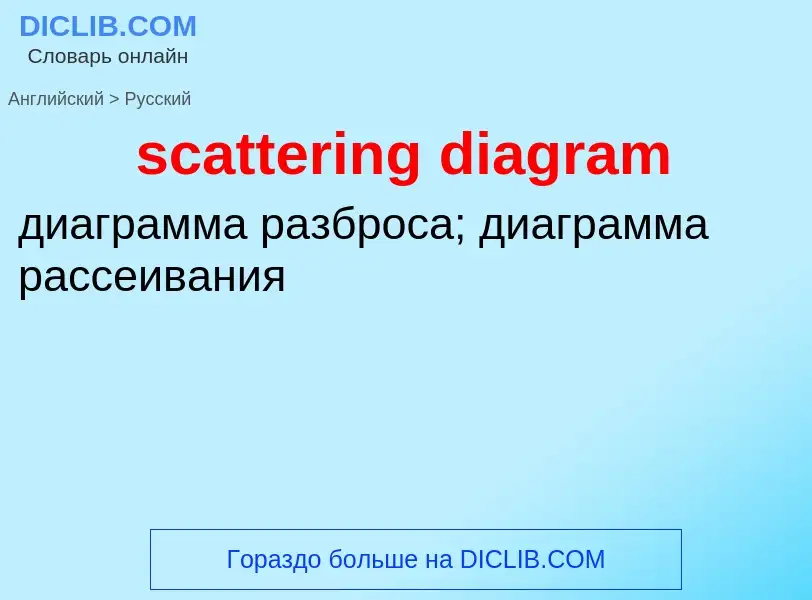Перевод и анализ слов искусственным интеллектом ChatGPT
На этой странице Вы можете получить подробный анализ слова или словосочетания, произведенный с помощью лучшей на сегодняшний день технологии искусственного интеллекта:
- как употребляется слово
- частота употребления
- используется оно чаще в устной или письменной речи
- варианты перевода слова
- примеры употребления (несколько фраз с переводом)
- этимология
scattering diagram - перевод на русский
общая лексика
диаграмма рассеивания
математика
точечная [корреляционная] диаграмма
скаттер-диаграмма
диаграмма разброса (способ графического отображения данных в виде точек в системе координат; в бухгалтерском учете используется для отображения объемов затрат для различных уровней производства или продаж, для разделения смешанных затрат на постоянную и переменную составляющие)
синоним
Смотрите также
[ven'daiəgræm]
общая лексика
диаграмма Венна (схема нормального кроветворения)
математика
диаграмма Венна (состоит из пересекающихся окружностей)
диаграмма Венна (состоит из пересекающихся окружностей)
общая лексика
рассеивающий центр
астрономия
диаграмма Герцшпрунга-Расселла
общая лексика
диаграмма усилий
строительное дело
эпюра нагрузок
диаграмма (Максвелла -) Кремоны
общая лексика
рассеяние рентгеновских лучей
рентгеновское рассеяние
Определение
Википедия
Møller scattering is the name given to electron-electron scattering in quantum field theory, named after the Danish physicist Christian Møller. The electron interaction that is idealized in Møller scattering forms the theoretical basis of many familiar phenomena such as the repulsion of electrons in the helium atom. While formerly many particle colliders were designed specifically for electron-electron collisions, more recently electron-positron colliders have become more common. Nevertheless, Møller scattering remains a paradigmatic process within the theory of particle interactions.
We can express this process in the usual notation, often used in particle physics:
In quantum electrodynamics, there are two tree-level Feynman diagrams describing the process: a t-channel diagram in which the electrons exchange a photon and a similar u-channel diagram. Crossing symmetry, one of the tricks often used to evaluate Feynman diagrams, in this case implies that Møller scattering should have the same cross section as Bhabha scattering (electron-positron scattering).
In the electroweak theory the process is instead described by four tree-level diagrams: the two from QED and an identical pair in which a Z boson is exchanged instead of a photon. The weak force is purely left-handed, but the weak and electromagnetic forces mix into the particles we observe. The photon is symmetric by construction, but the Z boson prefers left-handed particles to right-handed particles. Thus the cross sections for left-handed electrons and right-handed differ. The difference was first noticed by the Russian physicist Yakov Zel'dovich in 1959, but at the time he believed the parity violating asymmetry (a few hundred parts per billion) was too small to be observed. This parity violating asymmetry can be measured by firing a polarized beam of electrons through an unpolarized electron target (liquid hydrogen, for instance), as was done by an experiment at the Stanford Linear Accelerator Center, SLAC-E158. The asymmetry in Møller scattering is
where me is the electron mass, E the energy of the incoming electron (in the reference frame of the other electron), is Fermi's constant, is the fine structure constant, is the scattering angle in the center of mass frame, and is the weak mixing angle, also known as the Weinberg angle.




















![[[Stained-glass]] window with Venn diagram in [[Gonville and Caius College, Cambridge]] [[Stained-glass]] window with Venn diagram in [[Gonville and Caius College, Cambridge]]](https://commons.wikimedia.org/wiki/Special:FilePath/Venn-stainedglass-gonville-caius.jpg?width=200)


![main-sequence]] turn-off at different ages main-sequence]] turn-off at different ages](https://commons.wikimedia.org/wiki/Special:FilePath/Open cluster HR diagram ages.gif?width=200)


